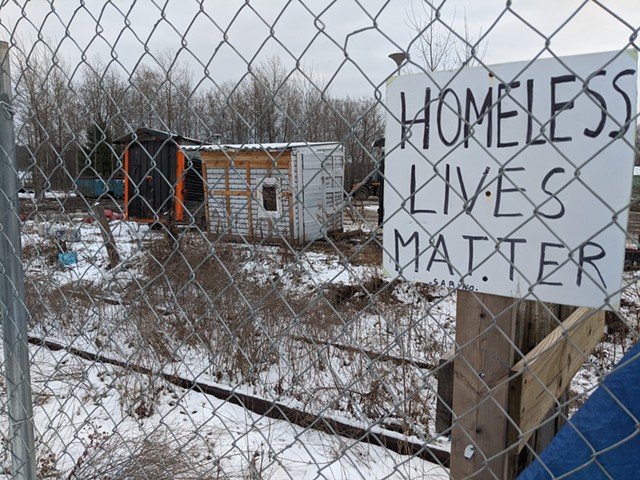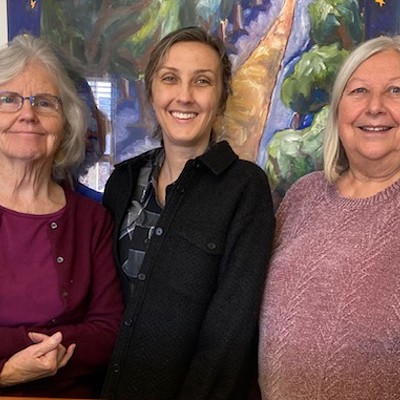click to enlarge 
- File: Courtney Lamdin ©️ Seven Days
- A sign at the former Sears Lane encampment
Results of the
Annual Point in Time Count were released Thursday and revealed a 7.3 percent increase in persons experiencing homelessness in Vermont since last year. The uptick followed a 133 percent increase from pre-pandemic 2020 to 2021, and occurred amid a
housing crisis in the state.
“I was a bit surprised by the increase from 2021 to 2022,” said Martin Hahn, executive director of the Vermont Coalition to End Homelessness. “We are housing people. People are moving out of hotels and into permanent housing. The discouraging component of this is that we're in a really rough housing market.”
In fact, the count does not capture the full picture of homelessness in the state, which is likely much larger than the federally mandated report shows. Each year, service providers count sheltered and unsheltered people experiencing homelessness across the state hoping to paint a broad picture. The effort is spearheaded by the Vermont Coalition to End Homelessness and the Chittenden County Homeless Alliance, and it captures the population of those defined as “literally homeless” in one evening in January. The organizations clarified that the count does not include those at risk of homelessness, doubled up with another household or couch surfing.
Interestingly, the number of persons experiencing homelessness in Chittenden County has gone down by 32 in the past year, but that's not indicative of decreased need, said Jess Graff. She is the co-chair of the coalition and associate director of the Franklin/Grand Isle Community Action, a division of the Champlain Valley Office of Economic Opportunity (CVOEO).
“Actual residents experiencing homelessness [in Chittenden County] is much higher than what was presented in the [point-in-time] count,” said Graff, who explained that many Chittenden County residents seeking temporary housing went to other parts of the state where motels had capacity.
Vermont's pandemic-era emergency housing program utilizes hotels and motels for temporary housing needs, and has been nationally lauded. At the onset of the pandemic, Vermont officials contracted with roughly 75 hotels and motels across the state to house the growing number of people experiencing homelessness, expanding a practice that was in place previously — but only for emergency situations.
That program was cut in the past year. In
July 2021, more restrictive guidelines limiting the number of people who are eligible for a room were put in place, displacing an estimated third of the roughly 2,300 people living in motels. And only a few months prior, the City of Burlington
moved forward with the forced disbanding of the Sears Lane homeless encampment
following two arrests there.
But starting July 1, the state is shifting gears. The program's Federal Emergency Management Agency funding will be replaced by Emergency Rental Assistance Program dollars. The shift will raise the income threshold for qualified participants.
The new program will also allow funding for participants in three-month increments, rather than monthly chunks, which should provide more stability for clients. Plus, motels will be paid proactively rather than retroactively.
Katarina Lisaius, senior adviser to the commissioner of the Department for Children and Families, clarified that the program is not ending, but rather reverting back to what it was before the pandemic. The new program will allow current beneficiaries to continue to stay in the hotels and motels they currently reside in if they continue to qualify for assistance, at least until next June. But Lisaius warned “how we ultimately address homelessness is with more permanent housing and housing stock.”
Anti-poverty activist Brenda Siegel camped on the Statehouse steps last fall to pressure the administration of Gov. Phil Scott to extend the program, which had been set to expire. Siegel, the presumptive Democratic candidate for Vermont governor, warned on Thursday that "we don't have a plan for what happens when [the new program] ends, and we don't have a plan for the people it's not going to work for."
While the census indicates a noteworthy increase in people experiencing homelessness, perhaps even more concerning are those who didn't make it into the report.
“I was on a call today with a service provider working with four victims of domestic violence who were unable to get a hotel room because there are no available rooms. They’re all full,” said Hahn. “Those people no longer count because they're doubled up somewhere. They're invisible in some ways to the network.”
Staff writer Rachel Hellman is a Report for America member. Learn more about the organization here.
























































